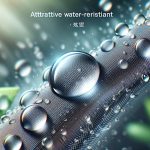When it comes to waterproofing, seam taping and fabric construction are essential elements you can’t overlook. Seam taping effectively seals critical junctions, while the choice of fabric impacts overall water resistance. Different materials and techniques can make a significant difference in performance. So, how do these factors interact to influence the reliability of your outdoor gear? Let’s explore the intricacies that determine whether you’ll stay dry in wet conditions.
Table of Contents
Key Takeaways
- Seam taping prevents water seepage through fabric connections, enhancing the waterproof integrity of outdoor gear.
- Quality fabric construction, especially synthetic materials, significantly improves water resistance compared to natural fibers.
- Specialized coatings on fabrics, combined with seam sealing, create a reliable moisture barrier for effective waterproofing.
- PU and TPU seam tapes differ in flexibility and durability, influencing their performance based on environmental conditions and intended use.
- Regular inspection and maintenance of seams are vital to sustain waterproof performance and prevent mold and mildew growth.
Importance of Seam Taping in Waterproofing
When you consider waterproofing, seam taping often becomes the unsung hero in the process. It’s not just about the fabric; it’s about how those materials connect. If seams aren’t properly taped, water can seep through tiny gaps, rendering your gear ineffective.
Seam taping adds an extra layer of protection, ensuring that even the most vulnerable areas stay dry. By using specialized tapes, you not only seal the seams but also enhance the overall durability of your fabric.
This technique is vital for outdoor gear, where exposure to the elements is unavoidable. So, when you’re evaluating waterproof gear, don’t overlook the importance of seam taping; it’s essential for keeping you dry and comfortable in any weather.
Overview of Fabric Construction for Enhanced Water Resistance
When it comes to enhancing water resistance, the choice of materials is essential.
You’ll find that integrating moisture barriers can markedly improve the overall effectiveness of your fabric construction.
Understanding these elements will help you create products that truly stand up to the elements.
Material Selection Importance
Choosing the right materials is essential for fabric construction aimed at enhancing water resistance. When you select fabrics, consider their water-repellent properties and breathability.
Synthetic materials like nylon and polyester often outperform natural fibers in resisting water, thanks to their tightly woven structures and inherent moisture-wicking capabilities. Additionally, look for fabrics with specialized coatings or treatments that strengthen water resistance without compromising flexibility.
Combining these materials with appropriate seam sealing techniques guarantees you create a reliable barrier against moisture. Ultimately, the right material choice not only improves waterproofing but also enhances comfort and durability, allowing you to stay dry and protected in various weather conditions.
Prioritize quality and performance to get the most out of your waterproof fabric construction.
Moisture Barrier Integration
After selecting the right materials, integrating moisture barriers is key to achieving enhanced water resistance in fabric construction.
You’ll want to take into account various types of barriers, such as polyurethane or Gore-Tex, which offer excellent waterproofing while remaining breathable. These barriers work by blocking water from entering while allowing moisture from sweat to escape, keeping you comfortable in wet conditions.
When constructing your fabric, verify the moisture barrier is properly sealed and layered with other materials to maximize performance.
Pay attention to seam construction as well; taped seams can greatly improve overall waterproofing.
PU Seam Tapes vs. TPU Seam Tapes: A Comparative Analysis
While both PU and TPU seam tapes are designed to enhance the waterproofing of fabric, their distinct properties can greatly impact your choice based on specific project requirements.
PU seam tapes are generally more flexible and easier to apply, making them ideal for lightweight fabrics and casual outdoor gear. However, they can degrade under UV exposure over time.
On the other hand, TPU seam tapes offer superior durability and resistance to extreme temperatures, making them better suited for heavy-duty applications like mountaineering gear. They might be stiffer, affecting the fabric’s overall feel.
Ultimately, your decision should hinge on the intended use and environmental conditions, ensuring you select the right seam tape for ideal waterproofing performance.
The Role of Seam Sealing in Preventing Water Leakage
Seam sealing plays a pivotal role in waterproofing by effectively preventing water leakage at the most vulnerable points of a fabric. When you choose gear with sealed seams, you’re investing in protection against moisture intrusion.
Taped or welded seams provide a barrier that complements the fabric’s waterproof properties, ensuring water can’t seep through those vital junctions. Without proper seam sealing, even the best waterproof materials can fail, allowing water to penetrate and compromise your gear’s performance.
It’s particularly important in high-stress areas like shoulders, hoods, and zippers, where the likelihood of leaks increases. Ultimately, effective seam sealing enhances your overall experience by keeping you dry and comfortable in wet conditions.
Impact of Fabric Material on Waterproofing Performance
When it comes to waterproofing performance, the choice of fabric material can make all the difference. You’ve got various options, like nylon, polyester, and Gore-Tex, each with unique benefits.
Nylon is lightweight and durable, making it a popular choice for outdoor gear. Polyester, on the other hand, offers excellent UV resistance and maintains its shape well.
Gore-Tex, known for its breathability and waterproof capabilities, can keep you dry in the harshest conditions. It’s crucial to take into account how these materials handle water repellent coatings, which enhance their performance.
Technologies in Seam Taping: Thermal vs. Ultrasonic
As you explore waterproofing technologies, understanding the differences between thermal and ultrasonic seam taping can greatly enhance your gear’s performance.
Thermal seam taping involves using heat to bond tape to the fabric, creating a strong and waterproof seal. This method works well with a variety of materials, ensuring durability.
Thermal seam taping uses heat to create a durable, waterproof bond between tape and fabric.
On the other hand, ultrasonic seam taping uses high-frequency sound waves to fuse the tape to the fabric without heat. This technique is often lighter and can maintain the fabric’s integrity better, especially in lightweight gear.
Choosing between these methods depends on your specific needs—if you’re looking for strength, thermal might be your go-to, while for lightweight performance, ultrasonic could be ideal.
Challenges in Achieving Optimal Waterproofing
When it comes to waterproofing, preventing seam leakage is a major challenge you’ll face.
You also need to think about how environmental factors can impact the effectiveness of your waterproofing strategies.
Finding the right balance between durability and sustainability can make all the difference.
Seam Leakage Prevention Strategies
Although achieving ideal waterproofing can be challenging, implementing effective seam leakage prevention strategies is essential for guaranteeing the longevity and reliability of fabric constructions.
Start by choosing high-quality seam tape that matches your fabric type, as this can greatly reduce water infiltration. Confirm that seams are properly aligned during construction to avoid gaps where moisture can enter.
Additionally, consider using double-stitched seams for added strength and durability. Regularly inspect seams for wear and tear, especially in high-stress areas, and promptly repair any damage.
You might also explore specialized seam sealing products that enhance waterproofing. By adopting these strategies, you’ll enhance your fabric’s ability to resist seam leakage and improve its overall performance in wet conditions.
Environmental Impact Factors
Even with effective seam leakage prevention strategies, various environmental factors can pose challenges to achieving ideal waterproofing.
For instance, extreme temperatures can affect the fabric’s flexibility, leading to cracks and wear over time. UV exposure can degrade materials, weakening their waterproof capabilities.
Additionally, humidity levels can create conditions for mold and mildew, compromising the integrity of your waterproof gear.
Rain intensity also matters; heavy downpours can overwhelm lesser materials, allowing water to seep through. Wind-driven rain adds another layer of complexity, forcing water into seams or openings.
Understanding these environmental impacts helps you make informed choices about your waterproof gear, ensuring it performs well in the conditions you face.
Always consider these factors when selecting and maintaining your waterproof equipment.
Future Trends in Waterproofing Materials and Techniques
As technology advances, the future of waterproofing materials and techniques is poised for exciting innovations that promise enhanced durability and sustainability.
You can expect to see the rise of bio-based materials that reduce environmental impact while maintaining high-performance standards.
Additionally, nanotechnology is set to revolutionize waterproofing by creating ultra-thin coatings that repel water without sacrificing breathability.
Smart textiles, integrated with sensors, will monitor moisture levels and adapt accordingly, providing real-time protection.
Moreover, advancements in seam taping techniques will improve the overall integrity of waterproof garments, minimizing weak points.
Balancing Cost and Performance in Seam Taping Solutions
With the advancements in waterproofing materials and techniques, balancing cost and performance in seam taping solutions has become a critical consideration for both manufacturers and consumers. You want to guarantee that you’re getting the best value without compromising on quality. Here’s a quick comparison of different seam taping options:
| Type | Cost (per meter) | Performance Rating |
|---|---|---|
| Basic Tape | $0.50 | 3/5 |
| Mid-range Tape | $1.00 | 4/5 |
| Premium Tape | $2.00 | 5/5 |
Choosing the right seam tape involves understanding your needs, budget, and the specific conditions the fabric will face. It’s about striking the right balance for ideal waterproofing.
Frequently Asked Questions
How Does Seam Tape Width Affect Waterproofing Effectiveness?
Seam tape width directly impacts waterproofing effectiveness. Wider tape covers more surface area, sealing seams better against water intrusion. If you choose narrower tape, you might compromise protection, allowing moisture to seep through more easily.
What Environmental Factors Influence Seam Waterproofing Performance?
Environmental factors like humidity, temperature, and exposure to water can greatly influence seam waterproofing performance. You’ll notice that extreme conditions can compromise the integrity of seams, affecting their ability to keep water out effectively.
Can Waterproofing Be Improved Without Seam Sealing?
Did you know that 80% of waterproof failures occur at seams? While seam sealing is essential, you can enhance waterproofing through advanced fabric treatments, breathable materials, and durable coatings, ensuring better protection against moisture without sealing every seam.
Are There Specific Care Instructions for Waterproof Fabrics?
To care for waterproof fabrics, you should wash them gently with mild detergent, avoid fabric softeners, and air dry. Regularly check for any wear and reapply water repellents as needed to maintain effectiveness.
How Do Temperature Conditions Affect Seam Sealing Quality?
Temperature conditions can make or break seam sealing quality. In cold, the adhesive can harden too quickly, while excessive heat may weaken it. You’ve got to find that sweet spot for ideal performance and durability.
- Paint (Latex) on a Canvas Drop Cloth, Can It Be Saved? - June 9, 2025
- How to Get Fruit Juice Stains Out of Kids’ Cotton Clothes - June 9, 2025
- Removing Nail Polish From a Polyester Carpet - June 9, 2025





